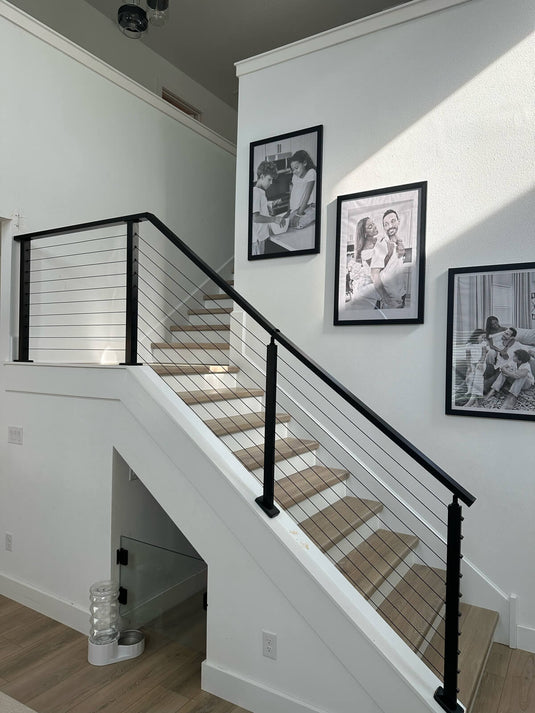TABLE OF CONTENTS
LED Lights on the Stairs: Why Do You Need Them?

Illuminating your home staircase with LED lights is a thoughtful integration of style, safety, and efficiency. As homeowners increasingly seek both aesthetic appeal and functionality in their living spaces, LED stair lighting has become a popular choice. This article explores the multifaceted benefits of installing LED lights on your stairs, offering insights into how they enhance home safety, complement interior design, improve energy efficiency, and facilitate easy installation.
Safety Benefits
First and foremost, the primary function of LED lights on staircases is to enhance safety by mitigating the dangers associated with poorly lit areas. In many homes, staircases can be shadowed and obscure, posing a significant risk of falls. This risk is amplified in households with children, the elderly, or residents with mobility challenges, where even a slight misstep can lead to severe consequences. By installing LED strips or fixtures, these areas are consistently illuminated, significantly reducing the chance of misjudging a step.
LED lighting solutions are particularly effective because they offer a bright, clear light that delineates each step distinctly. Unlike traditional lighting, which can create uneven shadows, LED lights provide uniform visibility, ensuring that each tread is visible from top to bottom without glare. The strategic placement of these lights, whether under the lip of each step or along the side walls, can help highlight the edges and contours of each step, which is crucial for night-time navigation.

Furthermore, integrating motion sensors with these lighting systems elevates their functionality. These sensors can detect activity on the staircase and activate the lights automatically, eliminating the need for manual switches and ensuring the lights are only on when necessary. This not only conserves energy but also means that the lights turn on instantly in response to movement, offering immediate visibility for anyone using the stairs. This feature is especially helpful during the night or in cases where one might have their hands full and cannot reach for a light switch.
This proactive approach to stair safety through LED lighting is a significant preventive measure that addresses the inherent risks of staircases in any home environment. By ensuring that the stairs are never in darkness, these lights provide both a practical safety solution and peace of mind for homeowners, knowing that the likelihood of accidents has been substantially reduced.
Easy Installation
The practicality of LED stair lights extends into their installation process. Many models are designed with user-friendly features, such as self-adhesive backs that can be quickly and securely attached to the underside of stair treads or along handrails. This design allows even those with minimal DIY skills to enhance their home safety and aesthetics without the need for extensive tools or complex procedures.

For installations that might require a bit more finesse—such as wiring that needs to be hidden or lights that are part of a larger home automation system—professional installation can be accomplished swiftly and with minimal disruption to the home. Professionals can often integrate these lights into existing electrical systems without significant alterations, maintaining the integrity and appearance of your home’s design. This ease of installation not only makes LED stair lighting an attractive option for many homeowners but also accelerates the adoption of this safe and stylish solution, enhancing living spaces efficiently and effectively.
Style and Aesthetics
Beyond their practical application, LED stair lights serve as a dynamic element of interior design, offering extensive options for customization and style enhancement. These lighting fixtures can be adapted to any decor style, from modern minimalist to classic and traditional, thanks to the variety of colors, intensities, and configurations available. Homeowners can choose from a spectrum of colors to either complement the existing palette or introduce a new accent color that adds a fresh dimension to the space.
The flexibility of LED lights in terms of installation and design allows for creative applications. For instance, installing strip lights under each step provides a floating effect that is both futuristic and elegant, while side-mounted lights can cast a softer glow that enhances the ambiance without overwhelming the senses. This versatility makes it possible to use lighting not only for functionality but also as an artistic tool to accentuate the architectural features of a staircase, such as carved banisters or intricate treads, bringing these elements into focus with precision lighting.
Moreover, the ability to adjust the brightness and color temperature of LED lights means that they can be set to create a warm, inviting atmosphere, a cool, clean vibe, or even a vibrant party mood. This adaptability ensures that the lighting can change with the occasion or time of day, providing everything from a subtle background glow to a striking visual statement.
Interior designers often leverage LED stair lighting to enhance or transform the aesthetic of a space. The strategic placement of these lights can draw the eye, guide movement, and influence the perceived size and shape of the area. By integrating these lights into the overall design scheme, they contribute significantly to the home’s visual narrative, offering both a practical and a stylistic payoff that unites safety with sophistication.
Energy Efficiency
These lights consume up to 80% less energy than traditional incandescent bulbs, which translates directly into lower utility costs and a marked reduction in household energy consumption. Such efficiency not only eases the financial burden associated with lighting but also significantly decreases the environmental impact of one's daily energy use.

LEDs have an impressive longevity, often lasting up to 25,000 hours compared to the 1,000-hour lifespan of typical incandescent bulbs. This extended lifespan means fewer replacements, which not only reduces the inconvenience and cost associated with changing bulbs but also lessens the environmental impact associated with manufacturing, packaging, and disposing of light fixtures. The cumulative effect of these factors positions LED stair lighting as a sustainable choice that aligns with eco-friendly living practices while also providing ongoing financial benefits.
Conclusion
LED lights on the stairs are more than just a decorative feature; they are a smart, sustainable, and safe enhancement for any home. From the clear safety benefits to the broad range of design options and the impressive energy efficiency, LED stair lighting is a practical upgrade that suits various needs and preferences. Moreover, the straightforward installation process ensures that this is a feasible project for almost any homeowner. Considering all these advantages, it becomes clear why LED lights are becoming an essential part of modern homes. Embracing this technology not only brightens your steps but also brings peace of mind, beauty, and functionality to your daily life.




